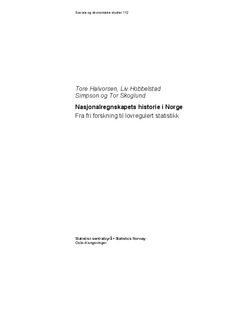| dc.description.abstract | Abstract
The Norwegian System of National Accounts has a long tradition compared with
most other countries. In Norway the first phase of the history of national accounts
was characterised by studies aiming at estimating the value of national income,
typically based on tax assessment statistics. The first work of this kind dates back
to the second half of the 19th century. A second phase occurred in the 1930s when
Professor Ragnar Frisch at the University of Oslo tried to design a general national
accounting system. His project was to include a detailed empirical description of
the Norwegian economy, industry by industry, in national accounting terms. The
empirical work on national accounting initiated by Frisch was, however, too
ambitious for its time. But his work had a strong theoretical basis, which proved to
be fundamental for the development of national accounts in Norway. The term
"nasjonalregnskap" (national accounts) was already used by Frisch in print in 1933
and Frisch's system of economic concepts (The Eco-circ System) became
worldwide renowned.
The work of national accounts of a "modern" type started in Statistics Norway in
1946 and was led by Odd Aukrust. The early Norwegian national accounting
system was based on concepts and definitions taken over from Frisch's Eco-circ
System, combined with an accounting structure along the lines proposed by
Richard Stone in a report published by United Nations in 1947. The Norwegian
system was also influenced by Wassily Leontief’s work on input-output. The
empirical results were first published in 1952 and covered the periods 1930-1939
and 1946-1951. A theoretical discussion of the principles underlying the estimates
was completed by Aukrust in 1955 and became an important milestone in respect
of national development as well as giving impulses internationally to revising the
UN system of SNA later on. Odd Aukrust was Director of Research at Statistics
Norway until he retired in 1984. He made important contributions, not only to
national accounting, but also to the use of the figures in many different respects
(growth studies, income analyses, macroeconomic policy etc).
Already in the pioneering years of Frisch and Aukrust there was the standpoint that
"real phenomena" was what mattered. It also reflected the particular interest public
authorities showed in the real flows in economy. The statistical base early became
considerably better for production statistics than for income and financial statistics.
Therefore, the production approach was the clear choice of main approach for
computing GDP. ------ Professor Ragnar Frisch ved Universitetet i Oslo startet på 1930-tallet arbeidet med
å stille opp et nasjonalregnskap for Norge. Etter krigen ble arbeidet videreført i
Statistisk sentralbyrå under ledelse av Odd Aukrust. En viktig drivkraft var behovet
for statistikk til nasjonalbudsjettet – statsadministrasjonens nye rammeverktøy for
økonomisk planlegging og politikk. Arbeidet ble også påvirket av tilsvarende
prosjekter i andre land og det internasjonale standardiseringsarbeidet som ble
påbegynt i de første etterkrigsårene. Beregningene resulterte i et nasjonalregnskap
som ble publisert i serien Norges offisielle statistikk i 1952.
Det norske nasjonalregnskapet var bygget opp rundt en kryssløpskjerne som viste
tilgang og anvendelse av varer og tjenester på et svært detaljert nivå. Norge var
blant de første landene som etablerte et integrert kryssløpsregnskap i nasjonalregnskapet,
med en godt utbygd industristatistikk som den sentrale datakilden. Norge
var også tidlig ute med å ta i bruk elektronisk databehandling (EDB) i nasjonalregnskapet
rundt 1960. Samtidig startet arbeidet med utviklingen av økonomiske
modeller i SSB, som bygde på nasjonalregnskapet som statistikkilde.
FNs nasjonalregnskapsstandard System of National Accounts (SNA) 1968, som var
basert på viktige innspill fra Norge og andre land, ga grunnlaget for en omfattende
hovedrevisjon av nasjonalregnskapet på 1970-tallet. I tillegg til innarbeiding av nye
definisjoner ble kvaliteten på nasjonalregnskapet forbedret ved at nye statistikkilder
ble tatt i bruk.
Den sterke veksten i oljevirksomheten etter 1970 stilte nasjonalregnskapet overfor
store metodemessige utfordringer, og har dessuten bidratt til at begrepet
”Fastlands-Norge” er blitt en sentralt begrep. | no_NO |
